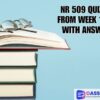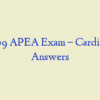Description
NR 509 Week 2 Quiz (25 Points) – Question and Answers
- A mother brings her two month old daughter in for an examination says “my daughter rolled over against the wall and now I have noticed that she has the spot soft on the top of her head, is there something terribly wrong?” The FNP‘s best response would be:
- During percussion the FNP knows that a dull percussion note elicited over a lung lobe. This most likely results from:
- The patient is unable to differentiate between sharp and dull stimulation to both sides of her face. The FNP suspects Damage to:
- When examining the face, the FNP is aware that the two pairs of salivary gland‘s that are accessible to examination are the _____ glands
- A patient comes to the clinic complaining of neck and shoulder pain and is unable to turn her head. The FNP suspects damage to cranial nerve ____ and proceeds with the examination by____
- When examining a patient’s cranial nerve function, the FNP remembers that the muscles in the neck that are innervated by CN XI are the:
- The patient’s laboratory data reveal an elevated thyroxine level. The FNP would proceed with an examination of the _____ gland
- A patient says that she has recently noticed a lump in the front of her neck below her “Adams apple” that seems to be getting bigger. During the assessment, the finding that leaves the FNP to suspect that this may not be a cancerous thyroid nodule is that the lump:
- The FNP notices that the patient’s submental lymph nodes are enlarged. In an effort to identify the cause of the node enlargement, the FNP would assess the patient’s:
- The FNP is aware that the four areas in the body were lymph nodes accessible are the: nr 509 week 2 quiz
- A 52-year-old patient describes the presence of occasional floaters or spots moving in front of his eyes. The FNP should know that floaters are usually not significant and are caused by:
- The FNP is preparing to assess the visual acuity of a 16-year-old patient. How should the FNP proceed?
- A patient’s vision is recorded as 20/30 when the Snellen eye chart is used. The FNP interprets these results to indicate that:
- A patient is unable to read even the largest letters on the Snellen chart. The FNP should take which action next:
- A patient’s vision is ……as 20/80 in each eye. The FNP interprets this finding to mean that nr 509 week 2 quiz
- When performing the corneal light reflex assessment, the FNP notes that the light is …..at 2 o’clock in each eye. The FNP should
- The FNP is performing the diagnostic positions test. Normal findings would be which of these results? nr 509 week 2 quiz
- During an assessment of the sclera of an African-American patient, the FNP would consider which of these an expected finding?
- A 60-year-old man is at the clinic for an examination. The FNP suspects that he has ptosis of one eye. How should the FNP check for this?
- The FNP is doing an assessment on a 21-year-old patient and notices that his nasal mucosa appears pale gray and swollen. What would be the most appropriate question to ask the patient?
- The FNP is palpating the sinus areas. If the findings are normal, then the patient should report which sensation?
- During an oral assessment of a 30-year-old African-American patient, the FNP notices bluish lips and a dark line along the gingival margin. What would the FNP do in response to these findings
- During an assessment of a 20-year-old patient with a three day history of nausea and vomiting the FNP notices dry mucous and deep vertical fissures on the tongue. These findings are reflective of:
- The FNP is reviewing the technique of palpating for tactile fremitus with a new graduate. Which statement by the graduate FNP reflects a correct understanding of tactile fremitus?
- The FNP student is reviewing physical assessment findings of the HEENT system associated with pregnancy. Which statement by the graduate FNP reflects a correct understanding of expected HEENT changes associated with pregnancy? During pregnancy:







